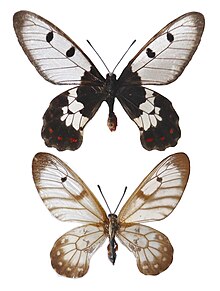Cressida (butterfly)
| Cressida cressida | |
|---|---|
 |
|
| Dorsal perspective of male (above) and female (below) C. c. cressida mounted specimens. A sphragis is partially visible on the female. | |
| Scientific classification | |
| Kingdom: | Animalia |
| Phylum: | Arthropoda |
| Class: | Insecta |
| Order: | Lepidoptera |
| Family: | Papilionidae |
| Genus: |
Cressida Swainson, 1832 |
| Species: | C. cressida |
| Binomial name | |
|
Cressida cressida (Fabricius, 1775) |
|
 |
|
| Distribution map of Cressida cressida in Australia. Note: distribution is not limited to Australia. | |
Cressida cressida, the clearwing swallowtail or big greasy, is a Troidine swallowtail butterfly found in northern Australia, New Guinea, Maluku, and Timor. It is in the monotypic genus Cressida.
Johann Fabricius acquired the first specimens of this species from Joseph Banks, who collected them at the site of present-day Cooktown in 1770. Fabricius described the male and female as Papilio cressida and P. harmonia respectively, under the premise that the two were different species. The original specimens now reside in the Natural History Museum, London. Both male and female now possess the same name, cressida, however, this species is no longer placed in the genus Papilio, but in the genus Cressida.
The eggs vary greatly in size. The caterpillars occur in several colour forms and possess yellow osmeteria that release a sweet smell. The caterpillars generally consume their entire food plant, and must travel along the ground to find another one. The chrysalis has a marble colouration, and is attached to dead grass or stones.
Adult males and females are quite dissimilar in appearance. However, both sexes have a black body marked with red scales and tough, transparent wings with limited scale covering. Both sexes have an unusually great range of size variation.
The spermatophore of Cressida cressida is modified into an external mating plug known as a sphragis (plural sphragides). The sphragis acts to increase the chance of individual males successfully producing offspring by preventing other males from inseminating already mated females. There is evidence that females have attempted to counter this strategy by evolving remarkably broad genitalia that makes it more difficult for sphragides to remain in place. The evolutionary incentive to counter the sphragis is likely the nutritional benefit females obtain from the spermatophore, hence multiple matings provide female butterflies with additional resources. The sphragis does not obstruct the passage of eggs as there are separate orifices for copulation and oviposition.
...
Wikipedia
